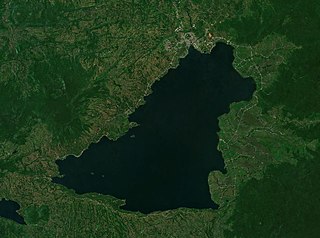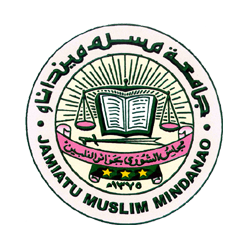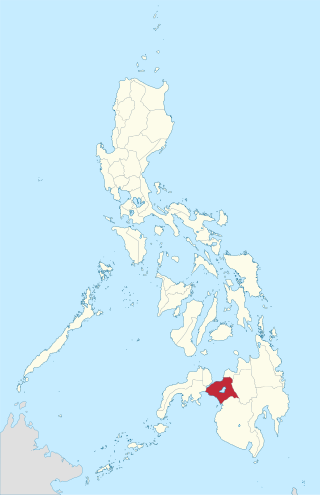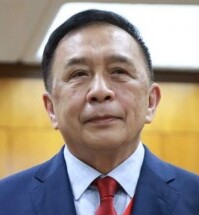
Lanao del Sur, officially the Province of Lanao del Sur, is a province in the Philippines located in the Bangsamoro Autonomous Region in Muslim Mindanao (BARMM). The capital is the city of Marawi, and it borders Lanao del Norte to the north, Bukidnon to the east, and Maguindanao del Norte and Cotabato to the south. To the southwest lies Illana Bay, an arm of the Moro Gulf.

The Autonomous Region in Muslim Mindanao was an autonomous region of the Philippines, located in the Mindanao island group of the Philippines, that consisted of five predominantly Muslim provinces: Basilan, Lanao del Sur, Maguindanao, Sulu, and Tawi-Tawi. It was the only region that had its own government. The region's de facto seat of government was Cotabato City, although this self-governing city was outside its jurisdiction.

Marawi, officially the Islamic City of Marawi, is a 4th class component city and capital of the province of Lanao del Sur, Philippines. According to the 2020 census, it has a population of 207,010 people.

The Maranao people, also spelled Mranaw,Muranaw, Maranaw, and Mëranaw and recognized also as the Iranaon or the Iranaoans, is a predominantly Muslim Filipino ethnic group native to the region around Lanao Lake in the island of Mindanao. They are known for their artwork, weaving, wood, plastic and metal crafts and epic literature, the Darangen. They are belong to the proto-danao language speakers closely with the Iranun people and they are one of the major Bangsamoro people in the Bangsamoro Autonomous Region in Muslim Mindanao and even in the country Philippines. They are also the tribe of Muslim Filipinos who are led to spreading fastest the popularity of Muslim Filipinos in the Philippines and the country Islamic Faith.

Lake Lanao is a large ancient lake in the province of Lanao del Sur, Philippines. With a surface area of 340 km2 (130 sq mi), it is the largest lake in Mindanao, the deepest and second largest lake in the Philippines, and counted as one of the 15 ancient lakes in the world. Scholars have been pushing for the lake's inclusion in the UNESCO World Heritage List. The lake's native people call themselves the Maranao or Meranaw. Their name was derived from the name of the lake, meaning "the people living around the lake".

Amai Manabilang, officially the Municipality of Amai Manabilang, is a 3rd class municipality in the province of Lanao del Sur, Philippines. According to the 2020 census, it has a population of 12,124 people.

Butig, officially the Municipality of Butig, is a 6th class municipality in the province of Lanao del Sur, Philippines. According to the 2020 census, it has a population of 22,768 people.

Malabang, officially the Municipality of Malabang, is a 3rd class municipality in the province of Lanao del Sur, Philippines. According to the 2020 census, it has a population of 49,088 people. The town is one of the two former capitals of the Sultanate of Maguindanao from 1515 until the Spanish conquered the land in 1888.

Saguiaran, officially the Municipality of Saguiaran, is a 4th class municipality in the province of Lanao del Sur, Philippines. According to the 2020 census, it has a population of 26,712 people.

The Moro people or Bangsamoro people are the 13 Muslim-majority ethnolinguistic Austronesian groups of Mindanao, Sulu, and Palawan, native to the region known as the Bangsamoro. As Muslim-majority ethnic groups, they form the largest non-Christian population in the Philippines, and according the 2020 census conducted by the Philippine Statistics Authority, they comprise about 6.4% of the country's total population, or 6.9 million people. However, the National Commission on Muslim Filipinos (NCMF) estimates that the population is closer to about 11% of the country's total population, or 10.7 million people, attributing the difference to a number of factors.

The Jamiatu Muslim Mindanao (JMM) is one of the oldest and biggest Madaris in the Philippines. It was established with the financial backing from the Agama Islam Society in 1956 by the late Sheikh Ahmad Bashir, his devoted companions from the Ulama (Ustad) and Traditional (Cali) Group. Its English Department was founded in 1987 through Board Resolution No. 1-87, series of 1987 and sought the government recognition in accordance with the provisions of the Ministry of Education, Culture and Sports (MECS) Order No. 24, series of 1985, also known as “Guidelines and Standards for the Recognition and Operation of Madaris.” In the same year, Ma’had Mindanao Al-Arabie Al-Islamia was changed and adopted its present name.

Ahmad bin Haji Bashir Mohammed Shafi was a Filipino Muslim Islamic scholar, leader, teacher, and founding president of the Agama Islam Society. He was born on 1 January 1919, in Miondas, Tamparan, Lanao del Sur, Philippines.

Lanao was a province of the Philippines from 1914 to 1959. Today, the province comprises Lanao del Norte and Lanao del Sur.
1895 in the Philippines details events of note that happened in the Philippines in the year 1895.

Saidamen Balt Pangarungan is a Filipino businessman, lawyer and politician who previously served as the ad interim Chairman of the Commission on Elections from March–June 2022. He previously served as the secretary of the National Commission on Muslim Filipinos in the Duterte administration, and was the governor of Lanao del Sur from 1988 to 1992.

Darangen is a Maranao epic poem from the Lake Lanao region of Mindanao, Philippines. It consists of 17 cycles with 72,000 lines in iambic tetrameter or catalectic trochaic tetrameter. Each cycle pertains to a different self-contained story. The most notable of which deals with the exploits of the hero Bantugan.

A torogan is a type of pre-colonial vernacular house of the Maranao people of the Philippines. A torogan was a symbol of high social status. They were very large buildings and served as the residence to a datu of a Maranao community, along with his retainers and their families. Nowadays, concrete houses are found all over Maranaw communities, but there remain torogans a hundred years old. The best-known are in Dayawan and Marawi City, and around Lake Lanao.

The siege of Marawi, also known as the Marawi crisis and the Battle of Marawi, was a five-month-long armed conflict in Marawi, Philippines, that started on May 23, 2017, between Philippine government security forces against militants affiliated with the Islamic State (IS), including the Maute and Abu Sayyaf Salafi jihadist groups. The battle also became the longest urban battle in the modern history of the Philippines.

The Amai Pakpak Medical Center (APMC) is a government hospital in Marawi, Lanao del Sur, Philippines.
Tarhata Alonto-Lucman was a Filipino politician and Maranao royalty who was the first female governor of the province of Lanao del Sur.


















